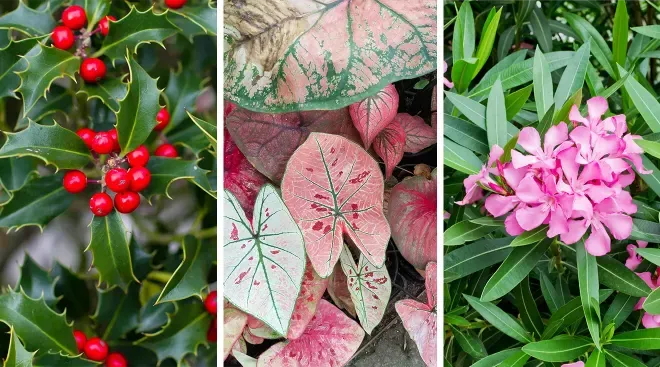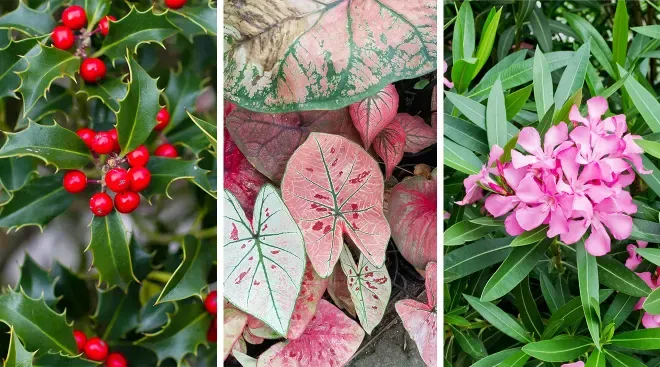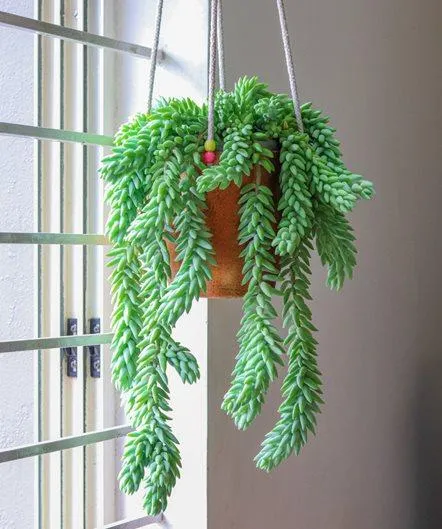The Complete Guide to Hanging Plant Names
If you’re looking to add some greenery to your home without taking up floor space, hanging plants are the way to go. From my experience as an avid gardener, hanging plants are a versatile and beautiful way to grow plants indoors or outdoors. In this article, I’ll cover the most popular hanging plant names and provide all the information you need to make an informed choice for your space. By the end, you’ll be an expert on these vertical beauties!
Trailing Plants
Trailing plants are known for their long vines or stems that grows downward, making them perfect for hanging baskets. Here are some top trailing plant options:
- English Ivy – One of the hardiest and easiest houseplants to care for. It thrives in low-light and trails beautifully. Watch out though, it’s invasive outdoors!
- Pothos (aka Devil’s Ivy) – Almost impossible to kill, pothos comes in various leaf color patterns and grows quickly. It’s tough as nails kind of plant.
- Wandering Jew – This colorful succulent trails beautifully with mint, purple or white foliages. It prefers filtered light.
- Spider Plant – Produces miniature plantlets on long stems that resemble spiderwebs, which you can propagate into new plants. Very low maintenance.
- Swedish Ivy – Similar to English Ivy but thinner foliage with dark green leaves that have cream edges. More compact growth habit too.
From my experience, trailing plants make fantastic hanging plants as their vines flow downward beautifully. Pothos and English Ivy have been my most carefree hanging plants to date. However, you need to watch the invasiveness of English Ivy if planting outdoors.
Flowering Hanging Plants
If you want a hanging plant that adds blooms, here are some top flowering options:
- Petunias – Cascades with colorful blooms spring through fall. Needs full sun for best flowering and comes in many colors like pink, purple, white.
- Bacopa – A low-maintenance trailing plant bearing tiny white flowers almost constantly. Thrives in partial shade.
- Begonias – Comes in rexi and tuberous types bearing red, pink or white flowers. Can be tricky with too much sun or cold drafts though.
- Fuchsias – Produces dangling flowers in red, pink, purple throughout summer. Needy plants requiring partial shade and consistent moisture.
- Lantana – A tender perennial treated as an annual. Bears clusters of orange, pink, yellow or red flowers attracting hummingbirds. Sun.
In my experience, petunias and bacopa have been the most carefree hanging flowering plants. Nothing beats the cheerful blooms of petunias cascading in a pot all summer long! Begonias tend to sulk if I’m not careful with their conditions.

Other Unique Hanging Plants
For something different, consider these unique hanging plant options:
- Air Plants (Tillandsia) – No soil needed, just mist them weekly. Comes in various sizes, shapes, and colors. Very low maintenance once established.
- String of Hearts – A stunning succulent with heart shaped green foliage trailing down in a continuous string. Water infrequently.
- Spider Plant Babies – Let your spider plant produce offsets, remove, and hang in their own nursery pot. Watch them grow large and full.
- Philodendron – Heart shaped foliage in green, cream or burgundy. Vining or clumping varieties available. Moderate light and moisture.
- Prayer Plant – Leaves fold inward at night, reopens during day. Loves humidity. Comes in green, burgundy or dark foliage.
Personally, I find air plants and string of hearts absolutely stunning! Their unique care needs make them a fun change from regular soil-growing plants. Spider plant babies have also been quite the hit with their whimsical trails.
Picking the Right Hanging Plant
Now that you’re familiar with top hanging plant varieties, how do you pick the best one? Here are some key factors to consider:
- Light conditions – Does the spot get full sun, partial shade or low light? Match plants to lighting.
- Water needs – How often will you remember to water? Pick low, moderate or high watering plants to suit your schedule.
- Climate – Is the area hot/humid, temperature controlled or exposed to drafts? Choose accordingly.
- Desired effect – Do you want trailing, vining, mounding or flowering? Consider growth habits.
- Container size – Will the plant’s mature size suit the available hanging basket or pot?
- Care level – How hands on versus carefree? choose low, moderate or high maintenance hanging greenery.
It’s key to match plants realistically to conditions for success. In my experience, more carefree plants in matched spots ensure happy hanging gardens with minimal fuss.
Tips for Hanging Plan Success
Now that you’ve selected your hanging plants, follow these pro tips to keep them thriving:

- Use the right potting mix – A lightweight, well-draining soil prevents soggy roots. I add perlite or bark to store bought soils.
- Provide adequate support – Use chains, closed hooks or boards sturdy enough to hold weight as plants grow heavier. Safety first!
- Water properly – Water thoroughly until water flows through, then discard excess in the saucer. Water less in winter for many plants.
- Fertilize occasionally – Use a balanced, diluted liquid houseplant fertilizer monthly spring through fall when plants actively grow.
- Prune trailing plants – Trim leggy stems on pothos, ivy to encourage bushier growth and shape cascading habit.
- Repot as needed – Overpotted plants may sulk. Repot into slightly larger pots using the same soil mix only when roots fill the container.
- Watch for pests – Isolate any infested plants and treat issues early before they spread using organic methods where possible.
Proper care makes all the difference, basically! After a few trial and errors, you’ll get the hang of tending your hanging gardens like a pro.
Frequently Asked Questions
Here are answers to some commonly asked hanging plant questions:
Q: Can I grow hanging plants indoors?
A: Absolutely! Many popular trailing plants like pothos thrive in low light indoor conditions. Just be sure to match them to available light.
Q: How do I water hanging baskets?
A: Water thoroughly from below until excess flows through the drainage holes. Or use a watering can with a long spout. Water less in winter when plants are semi-dormant.
Q: Which hanging plants flower all year?
A: Petunias, bacopa, and begonias often rebloom if old flowers are deadheaded. Lantana may reflower but seasonally

Guide to Choosing the Best Hanging Plant for your Space
| Plant Name | Light Requirements | Water Needs | Ideal Location |
|---|---|---|---|
| Pothos | Low to bright indirect light | Allow soil to dry out between waterings | Bedrooms, bathrooms, offices |
| Spider Plant | Bright indirect light | Water when top 1-2 inches of soil is dry | Kitchens, living rooms, porches |
| Philodendron | Medium to low light | Water when top inch of soil is dry | Bedrooms, bathrooms, living rooms |
| English Ivy | Low to medium light | Water when top inch of soil is dry | Bathrooms, bedrooms, hallways |
| Peperomia | Bright indirect light | Water when top inch of soil is almost dry | Bedrooms, bathrooms, offices |
FAQ
-
What kinds of plants can hang in my home?
There are loads of types of plants that do well hanging, like pothos, philodendron, spider plants, english ivy. Even some flowers like begonias or fuzzy trailing petunias can look rad hanging from above.
-
How do I care for hanging plants?
Hanging plants need sunshine, like most greenery. Give them a few hours of light each day, but not super intense direct sun or they might burn. Water when the soil becomes dry to the touch, usually once a week. You can use plant food during the growing season too to keep them healthy. Clean the leaves once in a while if they get dusty.
-
What is the best way to hang plants?
The easiest way is with craft string, twine or fishing line secured around the pot rim. You can also use hanging baskets, metal chains or ropes. Make sure the hanger and container are sturdy enough so it does not crash down. Secure higher than eye level if small humans or pets may bump into it. Safety first!
-
How do I choose the right hanging planters?
Look at the plant’s size when fully grown. You need a planter deep enough for good drainage that will not be too massive dangling above. Terra cotta or plastic are lightweight options. Some hanging pots even have holes to run a hanger wire through for stability. Consider how much rain or water your plants may get too.
-
Can any plant hang anywhere in the home?
Despite what plant stores may claim, not all plants are suited for every condition. Some prefer shade over sun or require extra humidity. Check if the space gets enough light before choosing. Also think about potential mess – you may not want a drippy plant above your couch! Place accordingly.

-
How do I maximize the visual impact of hanging plants?
Group pots together hanging from one hook for a fuller look. Use a variety of textures, sizes and colors. Consider having some spill over the edges dramatically. And don’t forget to refresh or replace plants when they get leggy looking. A pro gardener once told me deadheading spent flowers also keeps plants looking their best.
-
What is the best way to water hanging plants?
You have a few options. Many people use a watering can aimed upward, which can get messy. I kinda prefer a water bottle with a narrow spout. Some people even use a pump spray mister. Whichever method you pick, make sure potting soil gets completely saturated without over-waterlogging. Might need to slip a plate under just in case!
